Borzoi
The Borzoi[lower-alpha 1] or Russian Hunting Sighthound[lower-alpha 2] is a Russian breed of hunting dog of sighthound type. It was formerly used for wolf hunting,[2]: 125 and until 1936 was known as the Russian Wolfhound.[2]: 130 [3]
| Borzoi | |||||||||||||||||||||||||||||||
|---|---|---|---|---|---|---|---|---|---|---|---|---|---|---|---|---|---|---|---|---|---|---|---|---|---|---|---|---|---|---|---|
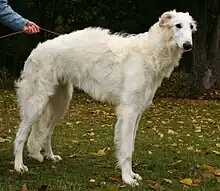 | |||||||||||||||||||||||||||||||
| Other names |
| ||||||||||||||||||||||||||||||
| Origin | Russia | ||||||||||||||||||||||||||||||
| |||||||||||||||||||||||||||||||
| |||||||||||||||||||||||||||||||
| Dog (domestic dog) | |||||||||||||||||||||||||||||||
Etymology
The system by which Russians over the ages named their sighthounds was a series of descriptive terms rather than actual names. Borzoi is the masculine singular form of an archaic Russian adjective that means 'fast'. Borzaya sobaka ('fast dog') is the basic term for sighthounds used by Russians, though sobaka is usually dropped. The name psovaya derived from the word psovina, which means 'wavy, silky coat', just as hortaya (as in hortaya borzaya) means shorthaired. In modern Russian, the breed commonly called the Borzoi is officially known as russkaya psovaya borzaya. Other Russian sighthound breeds are stepnaya borzaya (from the steppe), called stepnoi; and krimskaya borzaya (from the Crimea), called krimskoi.[4]
History

_Wolf_hunt_with_borzois.jpg.webp)

The Borzoi originated in sixteenth-century Russia by crossing Saluki and European sighthounds with thick-coated Russian breeds.[5][6]
The Borzoi was popular with the Tsars before the 1917 revolution. For centuries, Borzois could not be purchased but only given as gifts from the Tsar. Grand Duke Nicholas Nicolaievich of Russia bred countless Borzoi at Perchino, his private estate.[7]: 10 [8]
The Russkaya Psovaya Borzaya was definitively accepted by the Fédération Cynologique Internationale in 1956.[9]
Description
Appearance
Borzois are large Russian sighthounds that resemble some central Asian breeds such as the Afghan hound, Saluki, and the Kyrgyz Taigan. Borzois come in a variety of colours.[10] The Borzoi coat is silky and flat, often wavy or slightly curly. The long top-coat is quite flat, with varying degrees of waviness or curling. The soft undercoat thickens during winter or in cold climates, but is shed in hot weather to prevent overheating. In its texture and distribution over the body, the Borzoi coat is unique. There should be a frill on its neck, as well as feathering on its hindquarters and tail.[11][12]
Borzois are also known for their long snouts, which became the subject of an Internet meme.[13]
Temperament
The Borzoi is an affectionate and athletic breed of dog with a calm temperament.[14]
In terms of obedience, Borzois are selective learners who quickly become bored with repetitive, apparently pointless activity, and they can be very stubborn when they are not properly motivated. For example, food rewards, or "baiting", may work well for some individuals, but not at all for others. Nevertheless, Borzois are definitely capable of enjoying and performing well in competitive obedience and agility trials with the right kind of training.[7]: 113 [15][16]
Health
Stated life expectancy is 10 to 12 years.[17][18] Median lifespan based on a UK Kennel Club survey is 9 years 1 month. 1 in 5 died of old age, at an average of 10 to 11.5 years. The longest lived dog lived to 14 years 3 months.[19] Dogs that are physically fit and vigorous in their youth through middle age are more vigorous and healthy as elderly dogs, all other factors being equal. In the UK, cancer and cardiac problems seem to be the most frequent causes of premature death.[20]
- Coat colours
 Red
Red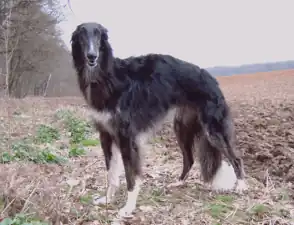 Black
Black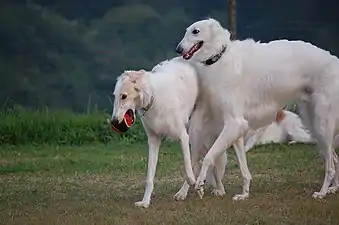 White and yellow-and-white
White and yellow-and-white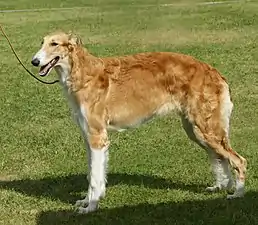 Red and white
Red and white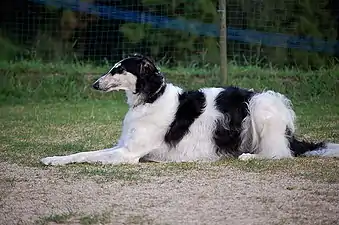 Black and white
Black and white White and brown
White and brown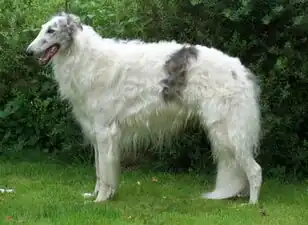 White and grey
White and grey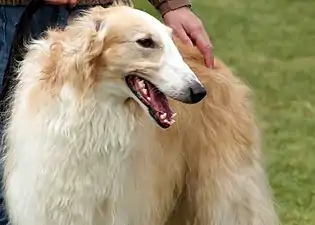 White and sandy
White and sandy
Notes
- borzaya, meaning 'swift' in Russian;[21]: 149 English plural either 'Borzoi'[lower-alpha 3] or 'Borzois'[lower-alpha 4][lower-alpha 5]
- Russian: русская псовая борзая, romanized: russkaya psovaya borzaya, lit. 'Russian long-haired sighthound'
- "theborzoiclub.org.uk". theborzoiclub.org.uk. Retrieved 26 April 2014.
- "Borzoi". Dictionary. Retrieved 26 April 2014.
- "Definition of Borzoi in Oxford dictionary (British & World English)". Oxford dictionary. Archived from the original on 24 December 2013. Retrieved 26 April 2014.
References
- FCI-Standard N° 193: Russkaya Psovaya Borzaya (Borzoi – Russian Hunting Sighthound). Fédération Cynologique Internationale. Accessed June 2022.
- Kim Dennis-Bryan (2020 [2012]). The Complete Dog Breed Book, second edition. London: Dorling Kindersley. ISBN 9780241412732.
- Sabaneev L.P. (1993). Hunting dogs: borzois and hounds (in Russian). Moscow: Terra Publishing. p. 571. ISBN 5-85255-188-0.
- Сабанеев, Леонид (2 December 2021). Собаки охотничьи. Борзые и гончие (in Russian). Litres. ISBN 978-5-04-333011-6.
- "Borzoi | Breeds A to Z | The Kennel Club". www.thekennelclub.org.uk. Retrieved 29 April 2022.
- Martin, Nellie (2005). Borzoi - The Russian Wolfhound. Its History, Breeding, Exhibiting and Care. Vintage Dog Books. ISBN 1846640423.
- Desiree Scott (2002). Borzoi. Dorking, Surrey: Interpet Publishing. ISBN 9781903098936.
- Kalamaras, G. (2019). "For All the Russian Wolfhounds—the Borzoi—Slaughtered During the Revolution, 1917". Undocumented: 156–157. doi:10.14321/J.CTVJSF4HW.90. ISBN 9781609175870. S2CID 198844826.
- FCI breeds nomenclature: Russkaya Psovaya Borzaya. Fédération Cynologique Internationale. Accessed June 2022.
- "Borzoi Colors and Markings". American Kennel Club. Retrieved 19 March 2012.
- "The Borzoi Standard". Borzoi Club of America. Archived from the original on 7 March 2012. Retrieved 19 March 2012.
- Mischiha O. "Russian Borzoi". My Friend: The Dog. 2013: №1: 10–17.
- "Borzoi / Long Nose Dog". Know Your Meme. Retrieved 30 July 2023.
- "Borzoi". American Kennel Club. Retrieved 29 November 2018.
- "Borzoi Club of America, Inc". Borzoiclubofamerica.org. Archived from the original on 29 February 2012. Retrieved 23 May 2012.
- М, Венцеславский А. (14 March 2013). Псовая охота вообще (in Russian). Directmedia. ISBN 978-5-4460-1839-0.
- "NZKC – Breed Standard – Borzoi". New Zealand Kennel Club. Retrieved 3 November 2011.
- "Borzoi: Dog Breed Selector: Animal Planet". Animal Planet. Retrieved 3 November 2011.
- "Individual Breed Results for Purebred Dog Health Survey". Archived from the original on 13 August 2013. Retrieved 27 June 2012.
- Archived 14 February 2012 at the Wayback Machine
- A.M. Macdonald (editor) (1972). Chambers Twentieth Century Dictionary. London: Chambers. ISBN 055010206X
Further reading
- Chadwick, Winifred E. (1952). The Borzoi Handbook. London: Nicholson & Watson. Including a translation of The Perchino Hunt by His Excellency Dmitri Walzoff (1912).
- Martin, Nellie L. (2005). Borzoi—The Russian Wolfhound: Its History, Breeding, Exhibiting and Care. Read Books. ISBN 978-1-84664-042-1.
- McRae, Gail C. (1989). Borzoi (New ed.). TFH Publications. ISBN 978-0-86622-676-9.
- Savenkova, V. (2003). Russkaya Psovaya Borzaya. Moscow. ISBN 978-5170169740.